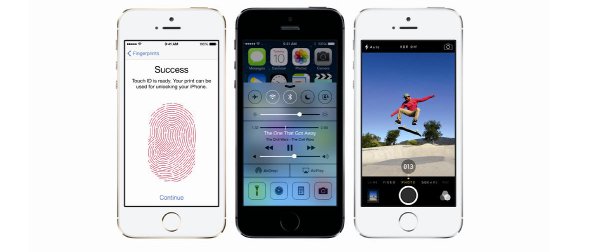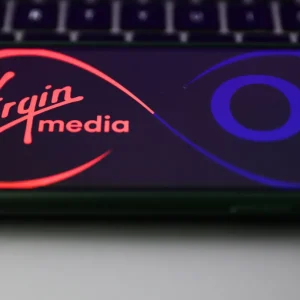
Apple has unveiled its new handsets in California: the iPhone 5S and 5C.
The iPhone 5S boasts finger print touch ID on the main home button and is available in black, silver and gold. The iPhone 5C is deemed the more affordable option, which features a plastic back in a choice of colours.
The 5S pricing begins at £549 for a Sim-free 16GB version and jumps to £709 for a 64GB handset. The 5C which has been dubbed as the more basic of the two has been priced at £469 for 16GB, Sim-free.
The smartphones will be available in the US, UK, China, Canada and Australia on September 20th.
We’ll be publishing expert reactions here as they come in.
Malik Saadi, principal analyst at Informa Telecoms & Media, comments on the iPhone launch: "The expected announcement of the two models today will mark a key change in Apple’s strategy as the company will break with its six year old business model of "one device fits all segments". Launching a cheaper smartphone will definitely help the company to reach new audiences, certainly in emerging markets where device subsidy is not a common practice and affordability is key.
All indications point to the fact that iPhone demand is increasingly shifting towards low price points. It can easily be seen from the ASP (average selling price) trend that older versions of iPhones offered at lower prices are becoming popular in emerging markets. This is a good indication that affordability is a key factor in these markets and the business case of offering a more affordable iPhone could be justified.
However, the company may face a number of challenges here. Offering premium and unique experiences to the user has always been the cornerstone upon which Apple has built every single product brand in its portfolio – and iPhone was no exception to this rule. In fact, the iPhone launch was instrumental in the take-off of the whole smartphone market. Competitors have been – and are still – struggling to compete with the iPhone despite their attempt to come out with "me-too" look-like devices with various form factors and at lower price points.
There is no doubt that the introduction of a cheaper version of the iPhone could extend the opportunities to lower price points and capitalize on the strength of the halo effect created by iPhone brand. Although this sounds like a natural step in bringing innovation to the affordable level, this strategy could backfire. Offering a cheaper version of iPhone at lower cost while the device looks very similar to its old brother in terms of functionality and experience means that it will undoubtedly be a success for Apple but this success will come at the expense of its flagship product. That is unless this version is addressed specifically at certain emerging markets, notably China where the brand is desirable but affordability is a barrier. However, if the cheaper version is aimed at the global market, including the developed world, it could have an adverse effect on the iPhone brand and could lead to cannibalization of premium devices.
Apple is facing an enormous competitive factor in this segment – the price of the device. However, getting the price "just right" (the Goldilocks effect) will be the company’s major challenge – too high and it will not hit the right market segments, too low and it risks endangering/diluting its brand value and strength. Large-scale deployment of the iPhone brand across different market segments could lead to brand dilution. Consumers could increasingly associate the iPhone with affordability and less with innovation and the premium experience that represent the key building blocks of the Apple brand."
Tony Cripps, principal device analyst at Ovum provides his view on the new releases: "Even post-Jobs Apple still does great theatre, even if most of what was announced was unusually well-heralded in the blogosphere.
Clearly there’s little need for gimmicks in the flagship 5S, in a launch replete with significant spec upgrades over and beyond the usual screen improvements. Apple, is certainly offering meaningful innovation here. Moving to a 64-bit architecture means Apple can genuinely claim to have brought something new to the smartphone party. It should certainly help the company further cement its lead as a mobile gaming platform and will give the Android fraternity something to think about in a space whose significance is sometimes downplayed beyond the gaming world.
Ingratiating itself to the burgeoning community of health and fitness application developers with new sensors is also a good move by Apple at a time when consumer and professional interest in those categories are booming.
Meanwhile the integrated capacitive fingerprint sensor will build legitimacy for the technology in mainstream consumer electronics, although privacy concerns are bound to raise their heads in these newly paranoid times.
Anyone expecting Apple to come truly down market with the iPhone 5C was fooling themselves. The day that happens is the day the company signals that it has run out of headroom for expansion. It’s far from ready to concede that yet as it’s greater interest in Japan and China show, although the mooted tie up with China Mobile wasn’t announced as this comment was written.
It does though indicate an acceptance that the consumers in the upper reaches of the smartphone mid-market are increasingly looking to distinctive devices of their own, and are not happy to accept cast offs or dumbed-down versions of former flagships.
Colour variations and a clear design of its own is a good way to do this and clearly Apple isn’t too proud to follow its smartphone rivals in using this tactic. This change hasn’t affected Apple too much to date but would have represented a threat if the company hadn’t addressed the problem now – its once a year refresh can sometimes work against it."
Tim Williams, director of product management at Absolute Software shares his thoughts on the new iOS7 launch: "Since Apple included the first hooks for managing mobile devices in 2010, it’s fair to say progress on similar enterprise features in iOS has been slow. iOS 7, however, represents the biggest leap forward so far, and one that delivers many long-awaited requests.
Many of the updates in iOS 7 completely change how enterprises can manage Apps at scale. Where previously, company-purchased apps had to be linked to employees’ personal Apple IDs, iOS 7 keeps the license linked to the central corporate account, even when it is deployed to employee-owned devices. Even better, these apps can be silently pushed to employee devices, with all the configuration settings applied.
Meanwhile, expanded "Open in…" dialogue and per-app VPN settings means you can dictate that certain types of documents and data can only be accessed in specific apps or securely across a VPN connection. This control element means employees can’t just share a document from a secure managed App to an unsecured personal one. Again, this is a huge leap forward for data security. And it also means VPN features can become a respectable and convenient concession rather than a device-dominating irritation.
The biggest consideration that is unaddressed by iOS 7 is nothing new. Ultimately, BYOD is not a technology challenge, it’s a business challenge. iOS 7 provides many new management features, but they won’t help until you have well-planned management policies.
Beyond that, effective management demands the intelligent automation of MDM to apply those policies to the right devices, at the right time, in the right way – not only on iOS, but on Android, Windows Phone and tablets. With manufacturers like Samsung increasingly adding their own features and embellishments to each of these, the variety of setups and mobile devices that your system needs to manage isn’t getting any smaller. It is also worth considering that your system will be in a stronger position if supported by smarter, more sophisticated mobile device management tools to pick up the ball and run with these innovations."
Rory Cellan-Jones, technology correspondent for the BBC sums up his views on the iPhone launch: "For all the usual superlatives about the amazing capabilities of its new phones, today’s Apple event was more about new markets than new technology.
True, the iPhone 5S does have one major innovation in the fingerprint sensor, a security feature which may help make consumers more confident in banking and shopping online.
What it hasn’t done is anything much to surprise and excite either investors or the wider world. Under Tim Cook, Apple is still waiting for a "wow" moment to give it new momentum."
Dr Ronald Klingebiel, assistant professor of strategy at Warwick Business School said: "The new iPhones are innovative, but they are still iPhones. Strategically, the direction seems unchanged. The lower-end iPhone is to address price competition in an increasingly commoditizing market, but the likes of Lenovo and ZTE achieve sufficient quality at much lower cost. At the upper end, the business model is about to change. There is a chance that the majority of value capture, which had migrated from the handset to the combination of OS and app store, will move on to apps themselves, reducing the cut for middle men. New entrants are gearing up to prise open the tight lock between handsets, operating systems, and app stores: Sailfish, Ubuntu, Firefox, and even Tizen offer next-generation operating systems that support the trend towards interoperable html-based apps. This could lead to an unbundling of the industry value chain and reduce Apple’s possibility to extract value from the iOS-app store nexus."
Vince Arneja, vice president of product management at Arxan Technologies gives his pre-launch views: "The latest iPhone presents new innovations in device security, if the rumours are to be believed, with a fingerprint scanner. This is certainly going to help protect users achieving more secure access to the physical device, but risks will still reside within the software perimeter. Certainly having a fingerprint scanner to access accounts would be more than ideal, however still key security considerations remain that require application layer protections from reverse engineering and tampering attacks.
We analysed the top banking applications on both Android and iPhone and found that all of them are vulnerable to these emerging hacker attacks and insertion of malware exploits, essentially meaning cyber criminals can take a legitimate app, crack it open and insert malicious code, then repackage and redistribute. The issue therefore does not stop at securing the device, mobile apps still require protection before they are deployed."
Following the iPhone 5S launch Jonathan French – security analyst for AppRiver, has blogged about the security benefits of the inclusion of a fingerprint sensor in the iPhone 5S. Highlights are pasted below and the full blog can be found here: http://blogs.appriver.com/Blog/bid/98762/The-iPhone-Now-with-a-Fingerprint-Reader
Jonathan French, security analyst for AppRiver has blogged about the security benefits of the fingerprint sensor on the iPhone 5S: "I see the major benefit of having this technology built in to the phones will hopefully be that more users will now secure their devices. Most people don’t seem to think about the information that is contained in their phones or the severity of having that information stolen. Most phones contain emails, personal contacts, and many apps that have synchronized passwords and other sensitive data. By not having a password or some sort of protection on a device, you’re open to anyone getting their hands on all of that data if you were to lose your phone or have it stolen. This stolen data may not only be personal either, many people with business email on their phones may lose some important or proprietary information. There have been numerous reports in the past of laptops and such being stolen out of peoples cars or phones snatched out of peoples hands on subways as the doors close. If you have no sort of authentication on your phone, all the data is there for anyone to access.
I see adding this feature as a good move on the security side of things and I hope more manufacturers consider adding security measures due to how popular mobile devices are. Fingerprint readers for the most part, are a secure method of authentication. It’s not perfect (I recall a famous myth busting show demonstrating this) but this new technology will hopefully be an easy authentication step for users to take in securing their phones. Making security easier for users to live with will make them more likely to use the proper security measures in the long run."
George Anderson, senior marketing manager for Webroot has commented on what the fingerprint scanner means for device security: "If implemented well on the iPhone, biometrics could become a great mobile security measure. If it turns out, however, that the fingerprint scanner will not be an additional security layer but a substitution for passcode authentication, that would be a disappointing news. Passcodes, while basic, are much less prone to errors than fingerprint biometrics. Biometrics is a temperamental technology and it should not be relied upon as a single security measure. A combination of both types of authentication is much more powerful from a security perspective than either on their own.
Mobile manufacturers should be always looking to layered security. They should make use of both passcodes and fingerprint verification for various actions – from unlocking the phone and making app purchases to gaining access to email and Wi-Fi connections. To the average user, this would mean the phone is protected when lost or stolen and for businesses, company information held on or accessed from that device is much more secure. As a provider of mobile security for Apple and Android devices, we’re hoping to see biometrics utilised by mobile device manufacturers in the future – but only as part of a security offering, not the sole defence."
Robert Rutherford, CEO of IT consultancy QuoStar Solutions comments on the release of iOS 7: "In keeping with tradition, Apple has kept its cards close to its chest leading up to the release of iOS 7, but with the latest release it feels less like a marketing ploy than an attempt to hide the lack of genuine innovation.
On the consumer side, the new OS’ facelift will no doubt divide opinion – and fuel the hype – but from a business perspective iOS 7 will leave the playing field wide open for competitors. In terms of innovation, Samsung, with its ‘smartwatch’ and tablet that recognises handwriting seems to be leading the way; in terms of business practicality, the suite of connected, high functioning Windows devices make some Apple products look like toys.
Apple will remain a major name in consumer electronics but it’s doubtful that iOS 7 will help it claw back any territory in the corporate world."






